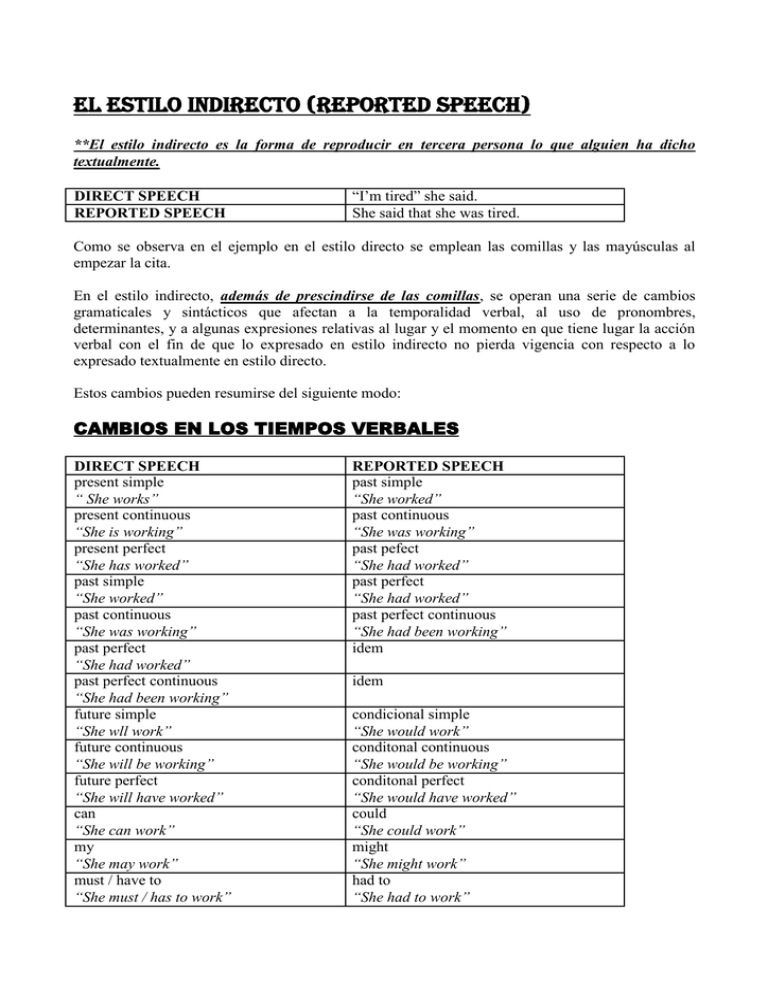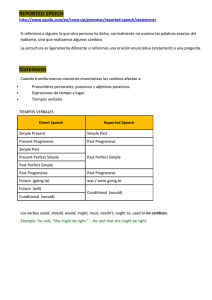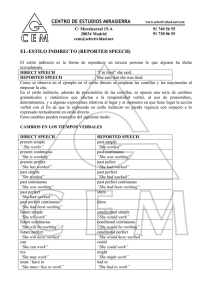el estilo indirecto (reported speech)
Anuncio

EL ESTILO INDIRECTO (REPORTED SPEECH) **El estilo indirecto es la forma de reproducir en tercera persona lo que alguien ha dicho textualmente. DIRECT SPEECH REPORTED SPEECH “I’m tired” she said. She said that she was tired. Como se observa en el ejemplo en el estilo directo se emplean las comillas y las mayúsculas al empezar la cita. En el estilo indirecto, además de prescindirse de las comillas, se operan una serie de cambios gramaticales y sintácticos que afectan a la temporalidad verbal, al uso de pronombres, determinantes, y a algunas expresiones relativas al lugar y el momento en que tiene lugar la acción verbal con el fin de que lo expresado en estilo indirecto no pierda vigencia con respecto a lo expresado textualmente en estilo directo. Estos cambios pueden resumirse del siguiente modo: CAMBIOS EN LOS TIEMPOS VERBALES DIRECT SPEECH present simple “ She works” present continuous “She is working” present perfect “She has worked” past simple “She worked” past continuous “She was working” past perfect “She had worked” past perfect continuous “She had been working” future simple “She wll work” future continuous “She will be working” future perfect “She will have worked” can “She can work” my “She may work” must / have to “She must / has to work” REPORTED SPEECH past simple “She worked” past continuous “She was working” past pefect “She had worked” past perfect “She had worked” past perfect continuous “She had been working” idem idem condicional simple “She would work” conditonal continuous “She would be working” conditonal perfect “She would have worked” could “She could work” might “She might work” had to “She had to work” CAMBIOS EN EXPRESIONES TEMPORALES Now / at the moment today yesterday tomorrow this week next week last week / month, etc. tomorrow morning yesterday evening then that day the day before / the previous day the next day / the following day that week the following week. the previous week / month, etc. the following morning the previous evening OTROS CAMBIOS this these here I / we my / our me / us mine / ours that those there he , she, it / they his, her, its / their him, her, it / them his,hers, its / theirs Además de los cambios antes mencionados, es necesario tener en cuenta la modalidad oracional antes de pasar de estilo directo a estilo indirecto. Desde este punto de vista podemos distinguir los siguientes tipos de oración: - Oración enunciativa (reporting statements) - Oración interrogativa (reporting questions) - Oración imperativa (reporting commands) - Oraciones que expresan petición o sugerencia (reporting requests and suggestions) - REPORTING STATEMENTS - En el estilo indirecto la frase suele empezar con un verbo como say, tell, ask, inquire, think, explain, complain, warn, point out, remark, declare, state, announce, protest, claim, etc., que son conocidos como reporting verbs y suelen aparecer en tiempo pasado. - A este verbo le sigue la partícula that, que puede ser omitida con los verbos say, tell y think. A continuación se aplican todos los cambios observados hasta ahora. DIRECT SPEECH REPORTED SPEECH “She is working at the moment” He said (that) he was working then. REPORTING QUESTIONS En las oraciones en estilo indirecto no se produce como en el estilo directo la inversión de orden entre sujeto y verbo. Es decir, una vez puesto el IF/WHETHER (yes/no questions) o el Pronombre Interrogativo (WH-Questions) DEBE seguirse un orden AFIRMATIVO (SUJETO + VERBO + COMPLEMENTOS). Además para su formación hay que distinguir entre las preguntas que se formulan con un pronombre interrogativo (Wh-questions) y aquellas pueden ser contestadas con un sí o no (yes/no-questions): a) Wh-questions Las preguntas que son formuladas con un pronombre interrogativo, pasan al estilo indirecto introducidas por ese mismo pronombre interrogativo. DIRECT SPEECH REPORTED SPEECH “Where do you live?” She asked where I lived. b) Yes/no-questions. Las preguntas que son susceptibles de ser contestadas por un sí o no pasan al estilo indirecto introducidas por la palabra if. DIRECT SPEECH REPORTED SPEECH “Is this your bag?” She asked if that was my bag.” REPORTING COMMANDS Al poner las órdenes en estilo indirecto: - Se pasa el imperativo a infinitivo manteniendo la forma afirmativa o negativa. DIRECT SPEECH REPORTED SPEECH - “Don’t smoke in my office” He told me not to smoke in his office. El verbo elegido para expresar el imperativo en estilo indirecto debe recoger el sentido de mandato, por lo que no se puede emplear say. Cuando se emplea el verbo tell debe colocarse un complemento de persona a quién se le da la orden. Además de tell se pueden emplear otros verbos con un significado semejante como ask, invite, warn, order, command, instruct,… REPORTING REQUESTS AND SUGGESTIONS. *PETICIONES - Al poner en estilo indirecto una petición de índole formal se debe colocar la persona que recibe la petición después del verbo que la introduce. DIRECT SPEECH REPORTED SPEECH “Mary, close the window, please” I asked Mary to close the window. - Entre los verbos más empleados para esta estructura se encuentran ask, demand, beg y request. Se omite la palabra please. Si en la petición aparece el verbo let, este debe aparecer también en el estilo indirecto, pero omitiendo el modal que le precedía. DIRECT SPEECH REPORTED SPEECH - “Can I you let me use your car,please?” I asked my father to let me use his car. Si no aparece let el verbo modal se mantiene. I asked my father if I could use his car. *SUGERENCIAS Se pueden expresar las sugerencias mediante diferentes expresiones: a) let’s…: b) why don’t we… c) shall we… d) why not… Para pasar una sugerencia al estilo indirecto, se introduce con el verbo “suggest” bien seguido de gerundio, bien de una oración subordinada introducida por that. I suggested going to the park. I suggested that we (should) go to the park.

